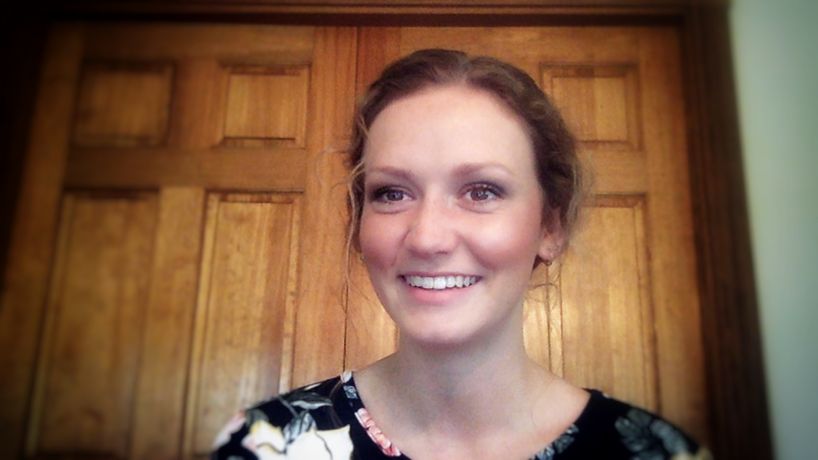
During her presentation at the Sport Literature Association Conference, graduate student Gabrielle Hines explored masculinity in poems about football. Classmates Malaya Siy and Emily Pott joined her in a panel focused on football poetry. (Photo by August Jennewein)
Football has dominated American sports for a long time, reigning as the country’s favorite since the 1970s. Fans know there is something magical about the game, whether it’s the loud cheers when a team scores a touchdown, the high energy of a tied game or simply an evening enjoying the crisp fall air.
It’s no wonder writers have immortalized the sport in hundreds of novels and movies. However, one genre seems incompatible with football at first glance – poetry.
Although it seems unlikely that the historically renowned form of writing could complement the boisterous modern sport, students Gabrielle Hines and Malaya Siy proved it’s possible through their presentations at the Sport Literature Association Conference, held virtually on June 18-20.
The students presented as part of Associate Professor of English Scott Peterson’s Special Topics in Literature class at the University of Missouri–St. Louis, which looked at the connections between sports and writing.
“Sports and academics have an interesting relationship,” said Hines, who is pursuing her master’s in English. “It used to be thought that academics and sports couldn’t mix and that academic pursuits about sports wouldn’t be taken seriously. That thought process has been going by the wayside, which I think is a positive change. Such a narrow perspective limits the fields of both academics and sports. Sports themselves have a major impact on our society, so it’s important that those impacts are explored in literature.”
Peterson, who helped organize the conference, set aside space where students could present their work. Hines and Siy, along with classmate Emily Pott, shared a panel on June 19 titled Social, Cultural and Political Issues Found in Football Poetry.
The panel’s topic stemmed from the first assignment they completed in Peterson’s class – a literary analysis over football poetry. Hines admitted her familiarity with the sport was limited, yet the high school teacher found a connection by looking at a study on adolescent football players and bullying.
She incorporated the study with the poems “Prison Chaplain” by Timothy Murphy, “Mercy” by Temple Cone and “Perfect Hit” by Ron Smith.
“I evaluated the football players’ performances of masculinity in football poetry,” she said in her abstract. “I discovered that the speakers were most empowered not when they embodied only traditionally masculine traits such as strength and competition, but when they fused them with traditionally feminine qualities like peace and compassion.”
Although showcasing research to a group of mostly strangers can be nerve-racking, Hines described her experience at the conference as positive.
“Everyone who listened to my presentation was very polite and I got positive feedback from a few listeners, which was very affirming as it was my first time ever doing something like that. It was immensely kind of Dr. Peterson to think of his students and what an awesome opportunity it would be for us.”
The panel also marked Siy’s first time presenting at a literature conference. The recent Saint Louis University anthropology graduate took Special Topics in Literature as a visiting student because it fit well with her work schedule.
“Going into a sport literature class, I wasn’t sure what I was getting myself into, but I think there’s a lot of value to understanding there’s more complexity than you see on the screen,” she said. “It’s definitely moving out of my comfort zone, a new way of looking at things.”
Siy’s presentation posed the question “What Do Stadiums Say?” Using “The Beauty of the Female Athlete” by Jennifer Kimble, she explored gender stratification within sports arenas and how women are portrayed in comparison to men, focusing on double standards.
Finding texts about women who play football proved to be a challenge, so Siy incorporated poems about female athletes from other sports as well, such as tennis icon Serena Williams.
Siy stated that a highly valuable part of the conference experience was hearing from other presenters.
“They were all really good papers,” she said. “It’s a good way to get in touch with other authors and see what they’ve been working on. A lot of good conversation comes out of it.”
Her passion lies in storytelling, which Siy believes will be an asset as she takes the next steps toward becoming a human rights lawyer. Conference presentations and literature papers help hone her storytelling skills through a relatable subject.
“Sports is a big part of a lot of people’s childhoods,” she said. “Whether we’re really into sports or not, we’re all familiar with a ball and a field. Sport literature dives into how all the people who are on that field came to be there and who’s watching them and what that relationship is. It gives us another side of it and explores the complexities.”














